The best thing in life are for free; sunshine, rain,
air and of course painting tips from paint experts. Painting a swimming pool is
not a job that you can wake up one day and decide that you want to do it. It
need careful and meticulous planning otherwise the result can be disastrous.
Information on a suitable paint system, the necessary tools and an expert
opinion are the key to getting excellent results.
What paint system are available for pools?
There are two standard types of swimming pool paints.
- Duracoat Chlorinated Rubber Enamel
- Duracoat Two pack Epoxy Enamel
Chlorinated rubber paint is more popular with concrete swimming pools and water parks. It dries to give a thick rubber, low to high sheen finish and a less likely to chalk on exposure to external elements. Due to it fast drying characteristics, Chlorinated rubber paint require to be thinned to appropriate velocity with chlorinated rubber thinner to ease application, especially on large surfaces.
Epoxy paint is a two-component system that dries to form a hard, gloss finish film that is resistant to most chemicals, detergents, bleaches, oils, weak solutions of acid and mixed together shortly before use and applied within its pot-life of less than 8 hours. Epoxy paint is commonly used on fiberglass and marble sheen pools due to its high durability. It can also be used on concrete pools.
How To Prepare The Pool For Painting
Before painting your pool, it needs to be drained and allowed to dry. The drying period may be one to two weeks depending on the prevailing weather conditions. A new concreate pool may require up to four weeks for proper curing before painting.
- If the job involves repainting the pool, determine what painting system was used previously. If it is Chlorinated Rubber, then you can only apply the same system. Applying Epoxy on top of chlorinated rubber will cause the paint to lift off the space.
- Clean your pool thoroughly to remove traces of oil, scum and any other impurities. Then rinse the surface with clean water.
- Repair any visible cracks.
- Ensure there is no rising dampness and moisture seeping from the surrounding areas. Sand the surface to roughen it and remove any loose and flaking particles.
Applying the paint
- Painting should be done during dry weather and in the cool hours of the day. Avoid hot midday temperatures as this may affect how paint cures.
- Use brush or roller to apply the paint on the wall then finish with the floor. Spraying may not get the paint into small cracks and fissures. Pay attention to ensure no patched are left out. At least 3 coats may be needed (primer inclusive) allowing 24 hours between coats.
- It is important to ensure your pool doesn’t come into contact with any water to allow paint to properly cure. How well the paint cures affects the dry fumes, its durability and lifespan.









